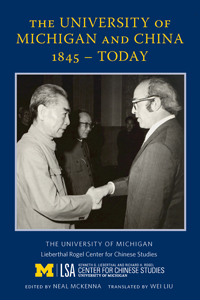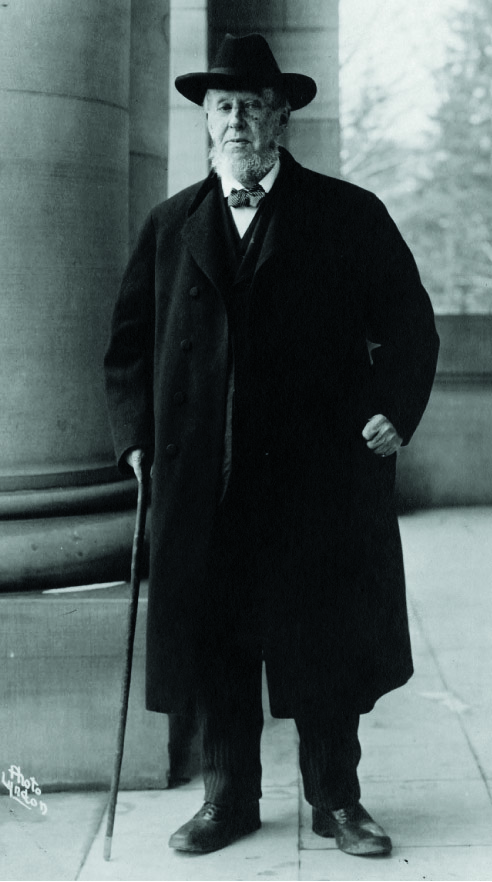
The University of Michigan and China 1845-Today
Skip other details (including permanent urls, DOI, citation information): This work is licensed under a Creative Commons Attribution-NonCommercial-NoDerivatives 3.0 License. Please contact [email protected] to use this work in a way not covered by the license.
For more information, read Michigan Publishing's access and usage policy.
Michigan and China: The Nineteenth Century
For a century and a half, the University of Michigan has had a close relationship with China. The immensely wide range of activities that constitute this relationship speak to the dedication of the university in fostering international understanding and progress.
The early and close ties between the university and China have been largely attributed to University of Michigan President James B. Angell, who took a temporary leave from the university in order to serve the U.S. government as Minister to China in 1880–1881.

Michigan’s administrators, academics, students, and alumni held an interest in China even prior to Angell’s tenure. For example, Anson Burlingame, who studied at the university from 1838 to 1841, was appointed by President Lincoln as Minister to the Qing Empire in 1861. He later served as a diplomat representing the Qing government in foreign relations with the United States and Europe. He negotiated a treaty that would bear his name (the Burlingame-Seward Treaty), which amended the Treaty of Tianjin and granted China “most favored nation” status with the United States. Further, Judson Dwight Collins (class of 1845) went to China as a missionary for two years after graduation. His diary, started the day after commencement, preserved a detailed account of his life and thoughts during his mission in China. It was not uncommon at that time for graduates of the nation’s leading universities upon receipt of their degrees to travel to China as missionaries or in other capacities.
When President Angell was appointed Minister to China, he was asked to negotiate a treaty regarding the influx of Chinese immigrants along the American west coast; their arrival had been stimulated by the need for inexpensive labor in the building of railways. Angell accepted the appointment with the support of the university’s regents, and with the university community well aware of the distinction this appointment afforded him and the university. The agreement Angell negotiated with the Qing government was later to form the basis of the Chinese Exclusion Act, which left a complex legacy in U.S.-Chinese relations.
Beyond this agreement, Angell’s work in China brought two significant changes to the University of Michigan. The first was the acquisition of an exhibit that the Chinese government had sent to the New Orleans World Industrial and Cotton Centennial Exposition. Thanks to Angell’s friendship with Sir Robert Hart, a prominent British employee of the Chinese government, the latter presented the exhibit to the university as a gift on behalf of the Chinese government. The exhibit was duly set up in the university’s museum space at the time, and for forty years it was a center of interest to students and visitors.
Following Angell’s term in China, the University of Michigan witnessed the arrival of Chinese students on its campus. This was the second change, and Angell himself had personally labored to make it possible. Upon the suppression of the Boxer Rebellion (1899–1901), foreign forces from eight countries (including the United States) demanded an indemnity of $333 million from the Chinese government over a period of forty years. Angell, together with other educators and like-minded people, pushed the U.S. government to return the Boxer Indemnity to China for the establishment of a scholarship program that would allow Chinese students to come to the United States to further their education. In 1908, the U.S. Senate passed a resolution remitting to China much of the U.S. share of the Boxer Indemnity, to establish the China Foundation for the Promotion of Education and Culture.
On April 29, 1911, Tsing-hua Xuetang, predecessor of the now prestigious Tsing-hua University in Beijing, was founded with part of the returned indemnity. It was the first preparatory school for those students who were later sent by the Chinese government to study in the United States. At the same time, a Chinese educational commissioner, while touring the United States in 1905 to determine schools for the indemnity students, placed the University of Michigan among the top five choices, along with Yale, Harvard, Columbia, and Cornell. Between 1911 and 1917, the University of Michigan’s student population included between fifty and seventy Chinese students, thus ranking it among the top three American universities in terms of Chinese student enrollment. The Chinese Student Club was founded at the University of Michigan around 1913 to represent Chinese students on campus and to organize activities.
Meanwhile, the tradition begun by Judson Dwight Collins also continued in its own way. Generations of University of Michigan graduates have gone to China, many working as missionaries. Among them were two Chinese women educated at the university, Ida Kahn and Mary Stone (1896 Medical School graduates).
Working as medical missionaries in their native country upon graduation, these two women deeply impressed one of the university regents, Levi Lewis Barbour, who was then traveling in Asia on a round-the-world trip. Upon his return to Michigan, Barbour started to plan for a scholarship specifically for Asian women that would allow them to come to the United States for education in whatever field they chose and then return to better serve their countries of origin.
In the nineteenth century, it was still rare for Asian women to have access to an education. The establishment of the Barbour Scholarships for Oriental women at the University of Michigan offered a unique opportunity for women to pursue a college education in the United States.





